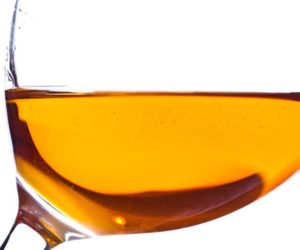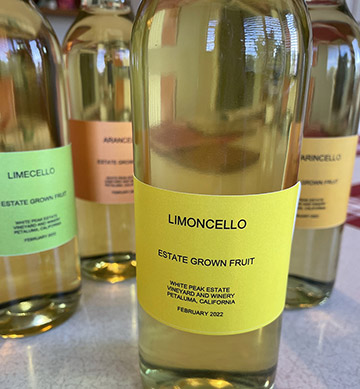
Limoncello is the most popular citrus-flavored liqueur, but they can be made from other fruits as well. Today we will take a look at my recent production of four different kinds of citrus liqueur that I am calling the four ‘cellos: Limoncello, limecello, arancello, and mandarincello.
Citrus trees can thrive in Sonoma County, California, where I live. Indeed, the city of Cloverdale at the north end of the county has an annual Citrus Fair complete with carnival rides and a wine tasting. Commercial growing is rare here, though, because most of the county experiences freezing temperatures every winter that make citrus risky as a cash crop. It’s left to home hobbyists who grow fruit for themselves, friends, and neighbors. Before she passed away several years ago, my mother had friends all around Petaluma (where she lived in our granny unit) who had lemon trees — it seems to be the most popular local citrus and does very well. When a heavy crop would come in, her friends would give Mom bags of lemons and she would try to use them up. She turned to me for assistance on one project she came up with: Limoncello.
A Brief History of Limoncello

Sweet, very aromatic, and smoothly spirited, limoncello (also sometimes spelled lemoncello) originated in Italy. It is usually presented in small glasses after dinner and served very cold. There are many stories of its origin, most dating to about 1900 but some claiming that it is an ancient monastic liqueur. Since I was introduced to it by a grandmother living in what might be considered a guest house (my mother in her granny unit), I like the origin story told by the Federvini — the Italian federation that unites producers and export/import companies involved in wine, liquor, and related products. Their story is that Signora Maria Antonia Farace was living in a guest house on Isola Azzurra around the turn of the last century. She tended a garden of lemon trees and treated guests to her homemade lemon liqueur: Limoncello. Her grandson later used her recipe to produce and serve limoncello in his restaurant and bar, then his son in turn went into the commercial production of it. You can read the Federvini story in Italian and the automated English translation is pretty good: https://www.federvini.it/trend-cat/215-breve-storia-del-limoncello
While limoncello dominates the citrus segment of liqueur shelves, other flavors are commercially available. Limoncello with an “i” reflects the Italian word for lemon, limone. Similarly, the related orange-flavored liqueur is called arancello, from arancia, meaning orange (the fruit). Some non-Italian brands and some home recipes call it orangecello, but I stayed with the Italian for mine. Italians use two words for lime fruit, limetta and lime. In using limecello, I named mine in both English and Italian. Mandarino is the Italian word for mandarin fruit, so mandarincello works fine for the name. I chose these four fruits because I grow them along the driveway in my front yard. Specifically, I used Lisbon lemons, navel oranges, Bearss limes, and Satsuma mandarins.
I planted my little citrus grove about eight years ago and it had been longer than that since I last made limoncello. Pompelmocello is a grapefruit version of the liqueur, but I don’t grow grapefruit. The same process could be followed if you like the flavor of grapefruits.
Tips for Making ‘Cellos
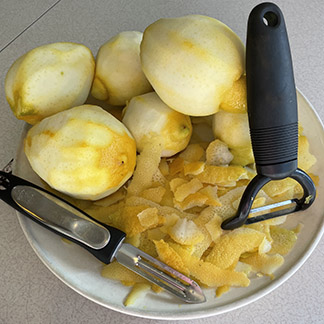
There are many recipes for the main version, limoncello, whether homemade or commercial. It is usually made using lemon zest, the outer layer of the peel without any pith. The zest is infused in grain alcohol or other neutral spirits and the liqueur is finished with a simple syrup made of sugar and water. Most versions come in at about 30% alcohol by volume (ABV). My mother’s recipe was one she found in the San Francisco Chronicle food section. Getting it out again and reviewing it, I decided to make a few changes. As written, the recipe used 100 proof (50% ABV) vodka for the zest infusion and aged the limoncello in bulk for 80 days. With liquor availability varying in different states and countries, I decided to rework the recipe with more common 80 proof (40% ABV) vodka instead, with the final ABV target unchanged at about 56 proof (28%). This was my first time making ‘cellos without Mom’s help, but I have previously made infusions of fruits and spices to make aperitifs and to flavor homebrews. The 80-day infusion period seemed much longer than necessary, so I shortened it to four weeks. Each batch of my recipe makes about 3.5 L (just under a gallon) of liqueur. If you are calculating gift-giving, that is enough for 14 of those square 250-mL flint (clear) bottles that your home wine supply shop probably sells, or about nine conventional 375-mL wine bottles. I used screw-cap 375’s for mine, but T-tops in cork-finish bottles should work fine, too.
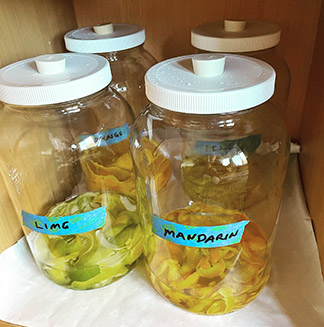
Before getting to the tasting notes, I’ll touch on some process tips that may help you use my recipe (on page 39). I used 1-gallon (3.8-L) wide mouth mason jars for this project. I only made half batches because I would be producing a lot of liqueur for just my wife, Marty, and I. As a result, pictures of my progress show the jars only half as full as they will be if you make the full batch size. To peel the fruit without getting any pith, I tried two different peelers. The pull-type potato peeler worked very well for me and I preferred it to the sideways push type. It was easy to remove just the outer layer of citrus skin and leave the pith on the fruit. Since my recipe uses no juice or pulp, you may reserve the peeled fruit for another recipe.
I wanted to use a neutral-tasting vodka, which means I stayed away from expensive imports that are well known for being flavorful. I chose Skyy vodka, but any well-filtered and low-flavored vodka will work well. I picked all of my fruit on the same day. A full batch requires 16 to 18 small fruits like limes or mandarins, about 15 average size lemons, 7 or 8 oranges, or three or four grapefruits. As the peel made contact with the vodka, the orange and lime showed some color within minutes. As you can see from the picture on page 36, only the lemon ultimately showed a bright hue, yellow with hints of green. The others surprised me by turning out mostly pale yellow-green. The lack of green in the limecello is at least partly due to the fact that the limes were ripe when I picked them. Bearss limes turn yellow at full ripeness, although they are typically picked while green to meet the visual expectations of the consumer. The flavor is unchanged as the color develops.
The amount of sugar for the simple syrup dissolved easily when brought to a boil with the specified water. I used RO water because I have a reverse osmosis system (that I also use when I brew beer). Any clean, good-tasting water will be fine.
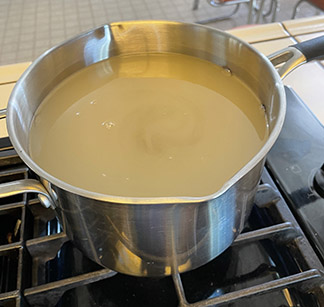
Citrus fruits have a long history of cultivation and crossbreeding. That results in many similarities of aromas and flavors. Limonene, chemically a monoterpene, is the most prominent aroma compound in citrus peels of all kinds. Like limoncello, it takes its name from the Italian limone. Citrus peel waste is used as a commercial source for the extraction of limonene to be used as a flavoring agent in other foods. It is also used as a more fragrant alternative to turpentine in paint and varnish cleanup. The shared characteristics of citrus have come about through extensive crossbreeding and hybridization of the plants since ancient times. Domestication of the genus Citrus began in tropical Asia and nearby Pacific islands, spread over centuries by canoe to the other Pacific areas and by ancient trade routes into the Mediterranean. Eventually various species and hybrids became distributed throughout the warmer parts of Europe and then on to the Americas. With hundreds of citrus fruit cultivars today, the earliest fundamental species are considered to be citrons (Citrus medica), pomelos (C. maxima), and mandarins (C. reticulata). All the other lemons, limes, oranges, and so forth owe some of their origin to these. By the time of ancient Rome, botanists were describing citrus cultivation in the Roman empire and carbonized citrus seeds are among the relics of Pompeii.
The Citrus Fruits
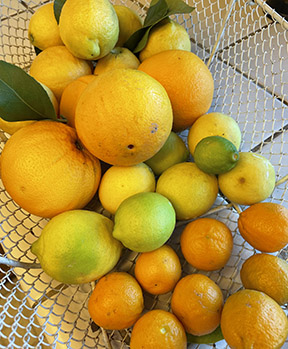
For our tasting of the finished ‘cellos, I took note of the particular citrus I am growing. Lisbon lemon is one of just a few lemon varieties (C. limon) that is generally considered a true lemon. (Meyer lemon, for instance, is classified as a cross between a citron and a Mandarin/pomelo hybrid). Fruit names such as lemon, lime, or tangerine refer to culinary use, flavor, and appearance of citrus fruits, but not necessarily to the species or hybrid. Lisbon lemons have a medium-thick skin that is rich in essential
oils, making it a good candidate for limoncello. The flesh is nearly seedless, produces lots of juice, and has very traditional “lemon” flavor without much sweetness.
Bearss lime, also called Persian lime, is a triploid (3-parent) cross between lemon (C. limon) and the key lime (Citrus x aurantifolia). Other varieties are sometimes sold as “limes,” but Persian lime is most common. My limes had mostly turned yellow by the day I picked them, although I went for the greenest ones I could find on the tree. Persian limes have thicker skins and less bitterness than key limes, making them suitable for limecello, but they also have less intense citrus aromatics.
The C. sinensis group of fruits is commonly referred to as the sweet oranges. The group includes Navel oranges, like the ones I used for my arancello, and blood oranges (which I also grow but didn’t have any mature ones on the tree at the time of this project). Navel orange fruit is seedless with a thick, bright orange skin. The fleshy pulp is sweet with moderate acidity and the zest is aromatic with traditional orange scent. The name is derived from the navel-like feature opposite the stem end — it lets you know you have a seedless orange in your hand. (The structure is actually an undeveloped twin fruit arising from a genetic mutation in Navel oranges.)
The Satsuma mandarin (C. unshiu) is said to have originated in either China or Japan. (Satsuma was a province in Japan before 1871.) These mandarins are sometimes called Satsuma oranges or tangerines. Its genetic origin indicates it to be a highly inbred mandarin-pomelo hybrid. One of the sweetest citrus fruits, it is usually seedless and the loose skin makes it easy to peel. For my project, that loose skin also made it a bit difficult to zest with a vegetable peeler as the skin tended to bunch up. The trees are considered among the most cold-tolerant of the citruses. The flesh is orange with mild acidity. The skin has characteristic tangerine-like aroma.
Bob’s Citrus ‘Cello Recipe
Makes about 3.5 L (3.7 qts. or 15 cups)
Ingredients
~4 lbs. (1.8 kg) fresh citrus fruits (this is about 15 lemons, for reference)
2-L (2.2-qts.) neutral-tasting vodka (80 proof/40% ABV)
4½ c (~2 lbs./910 g) granulated white sugar
3¾ c (900-mL) water
Step by Step
Wash the fruit and let dry. Over a medium-size bowl, remove the peel with a peeler or sharp paring knife. You want the colored zest of the fruit, but not the bitter white pith from underneath it. If you happen to get some pithy peel, scrape the pith off with a knife before adding the peel to your bowl.
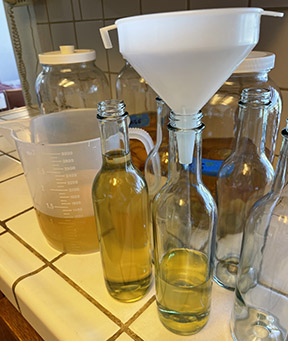
Transfer the peel to a 1-gallon (3.8-L) glass Mason jar. Add 1-L (1.1-qts.) of vodka. Stir, cover the jar, and set aside in a dark cabinet at room temperature.
After 14 days, take your vodka infusion out of the cabinet for the next step. Bring the sugar and water to a boil over medium heat in a saucepan. Simmer for five minutes, cover, and let cool for about an hour.
Add the sugar syrup to the vodka and citrus peel mixture and pour in another liter (1.1 qts.) of vodka. Stir well, cover, and put back in the dark. Store for an additional 14 days.
After the two-week storage period, bottle your ‘cello. Line a colander or strainer with doubled cheesecloth and place over a bowl that will hold at least a gallon (3.8 L) of liqueur. Pour the contents of your jar into the strainer, including any peel that falls out of the jar. Let drain and then discard peels.
Place a funnel in your choice of bottles. Scoop or pour liqueur into the bottle up to the lower part of the neck. Cap or cork, label, chill, and enjoy!
Tasting the ‘Cellos
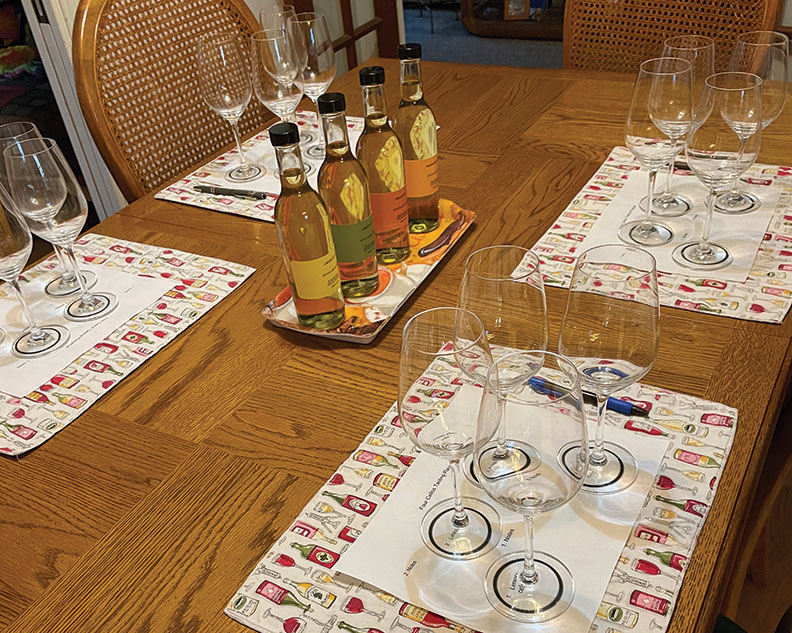
When all four ‘cellos were finished, I organized a tasting. Marty and I invited two younger adults with whom we have spent time during the pandemic, McLean Ketchum and Clayton Carter. I printed paper placemats with spots for four wine glasses and room to write notes directly on the mat. I poured about an ounce (30 mL) of each liqueur into each glass. We swirled, sniffed, sipped and discussed limoncello, limecello, arancello, and mandarincello in that order. As each taster recorded their own comments, I took notes on the general conversation. All four liqueurs had the same alcohol and sugar content, although we noted some apparent differences in the tasting. Although they would ordinarily be chilled, we tasted at room temperature to improve access to aromatics.
Limoncello
The aromas were reminiscent of lemon candies. We older tasters thought of lemon drops while our younger guests were reminded of Lemonheads. Clayton noted similarity to the aromas produced when baking a lemon cake. The aroma was much more lemony than the flavor, which was sweeter than expected. In comparison with some of the others, this one expressed lower bitterness.
Limecello
The lime aroma was distinctive, but not as strong as the lemon. The flavor had a bitter note with spicy, clove-like overtones. Clayton was reminded of tom yum soup, a Thai soup that includes lime juice, lemongrass, and kaffir lime leaves. The spicy and bitter notes also made this one seem hotter (more alcoholic) than the others even at the same ABV.
Arancello
The very distinctive orange aroma seemed a lot like store-bought orange extract. It also reminded some tasters of orange-flavored cold medicine. It was a little more bitter than the lemon, but not as bitter as lime. It seemed like the sweetest one to all of us and reminded me of the Nehi orange soda I drank in the years before I switched to adult beverages.
Mandarincello
This was the mildest of the four. The tangerine-like aroma was distinct from the orange, but not very strong. It had a touch of bitterness behind the delicate mandarin flavor. It was Marty’s favorite of the four, despite being the most subtle.
All four were very pleasant to drink. The best demonstration of that was that our guest tasters happily took home the rest of each 375-mL bottle to chill and enjoy later. So if you grow citrus fruit, or life (or a neighbor) gives you a bag of lemons, give this easy project a try. I think you will be very happy with the results — and so will your family and friends.


